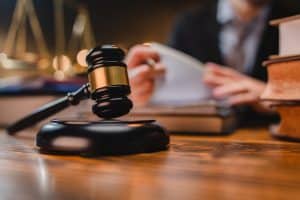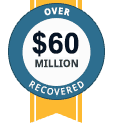What Is the Modified Comparative Negligence Law in Delaware?
 If you or a family member was involved in any type of accident, please get in touch with the personal injury lawyers at Silverman, McDonald & Friedman to schedule a meeting with us at one of our firm’s locations in Seaford, Newark, or Wilmington today.
If you or a family member was involved in any type of accident, please get in touch with the personal injury lawyers at Silverman, McDonald & Friedman to schedule a meeting with us at one of our firm’s locations in Seaford, Newark, or Wilmington today.
Being injured in an accident in Delaware may leave you wondering who is liable and whether you can obtain compensation. In Delaware, personal injury victims can seek and receive compensation from at-fault parties who acted negligently and caused their injuries. However, this can quickly turn into a difficult situation if multiple people are found liable. When this happens, the courts refer to the state’s modified comparative negligence law to determine who is legally responsible for the accident and how much they have to pay.
What is modified comparative negligence?
Each state has its own laws when it comes to determining liability and compensation in personal injury cases. For example, states across the country use contributory negligence laws, pure comparative negligence laws, and modified comparative negligence laws. Delaware is one of the many states that use a modified comparative negligence law to determine liability and compensation in personal injury cases.
Under this law, individuals who share liability in an accident can file a personal injury claim or lawsuit and seek damages for their injuries and other losses as long as they can prove that they are 50 percent or less at fault for the accident. This means that if you are 51 percent at fault for a car accident, you cannot recover compensation for your losses. If you are 30 percent at fault for the accident, the amount of compensation that you receive will be reduced by your degree of fault.
An example of modified comparative negligence
Sometimes, examples are the best way to understand comparative negligence. Here is a quick and simple example to illustrate how this policy may play out. Imagine Samuel is speeding in a sports car when he approaches an intersection. The traffic light at the intersection remains green, so he continues driving 55 mph in a 35 mph speed zone. Rebecca, who is driving an SUV, is distracted by her children in the backseat and runs the red light at the same intersection, resulting in a collision between the SUV and the sports car. Both individuals were severely hurt and claim that they suffered $80,000 in damages.
After the judge or jury analyzes the facts and circumstances of the case, they determine that both parties acted negligently and were at fault for the accident. Samuel was 40 percent at fault for the accident as he was speeding, and Rebecca was 60 percent at fault for the accident as she was distracted and ran the red light.
In this case, Samuel could recover damages from Rebecca, even though he was partly at fault for the accident, because his share of liability is less than 50 percent. Rebecca could not recover from Samuel, even though he was also negligent. However, Samuel’s speeding will impact how much he can recover from Rebecca. Because he was 40 percent responsible for the collision, he will recover only 60 percent of his total damages. In this case, he will be able to recover $48,000 (60 percent of $80,000), while Rebecca will recover nothing.
Why does proving negligence matter?
If you do not prove negligence, you cannot establish fault for your accident or determine who owes you compensation for the losses you suffered. Therefore, proving negligence is an essential part of a personal injury claim or lawsuit. You must do this by showing that the at-fault party owed you a duty of care, breached their duty of care by acting negligently, their negligence directly caused your accident, and you suffered damages as a result.
Evidence that can be used to prove negligence in a personal injury case
In order to increase your chances of proving negligence and obtaining the compensation you are entitled to, you will need to gather convincing evidence, such as:
- Police reports: Police reports give insurance companies, judges, and juries a look at the accident scene from the responding officers’ point of view. The responding officers usually provide details about what they saw and give their opinion on who they believe is responsible.
- Medical records: Medical records can help prove that the accident directly caused your injuries. These records also show the severity of your injuries, that you took the necessary steps to obtain medical treatment, and where you are on the road to recovery.
- Photographs: Photographs give the insurance companies, judges, and juries an up-close look at your injuries, the accident scene, and property damage. Photos are essential in showing how the accident happened and how it affected you.
- Videos: Videos used as evidence may include personal videos that you record, surveillance footage, or even dash cam footage. These pieces of evidence may reveal the sequence of events and details of your accident.
- Phone records: The unfortunate reality is that cell phones frequently cause accidents. Therefore, if you were involved in any type of accident and believe that the at-fault party was talking on their cell phone or sending a text message, you may be able to use phone records to prove this.
- Eyewitness statements: Eyewitness statements are provided by those who saw your accident occur. This could be a bystander, coworker, business owner, driver, pedestrian, bicyclist, or anyone else who was close to your accident scene. These statements usually back up the facts you provide or reveal additional information and details that you did not know or accidentally left out.
- Expert witness testimonies: Expert witness testimonies are provided by experts with some type of background, experience, or education in a field related to your accident. For example, a person with experience working on vehicles may be asked to provide testimony explaining how the auto mechanic or manufacturer’s negligence caused or contributed to your accident.
The Delaware personal injury attorneys at Silverman, McDonald & Friedman know how liability works in personal injury cases. Therefore, if you need help proving liability and obtaining the compensation you deserve to rebuild your life, our team is here to guide you through the process from start to finish. These cases can quickly become stressful, confusing, frustrating, and overwhelming, which is why we strongly suggest seeking advice from an experienced attorney as soon as possible. Please call our office or submit our contact form to set up an initial appointment at our offices in Newark, Wilmington, or Seaford today.

Attorney Jeffrey S. Friedman joined Silverman, McDonald & Friedman in 2001. He graduated from Widener University School of Law, and is admitted to practice law in Delaware and Pennsylvania, and in several Federal Circuit courts. He areas of concentration include auto accident and workers’ compensation cases. Read more about Attorney Friedman here.

